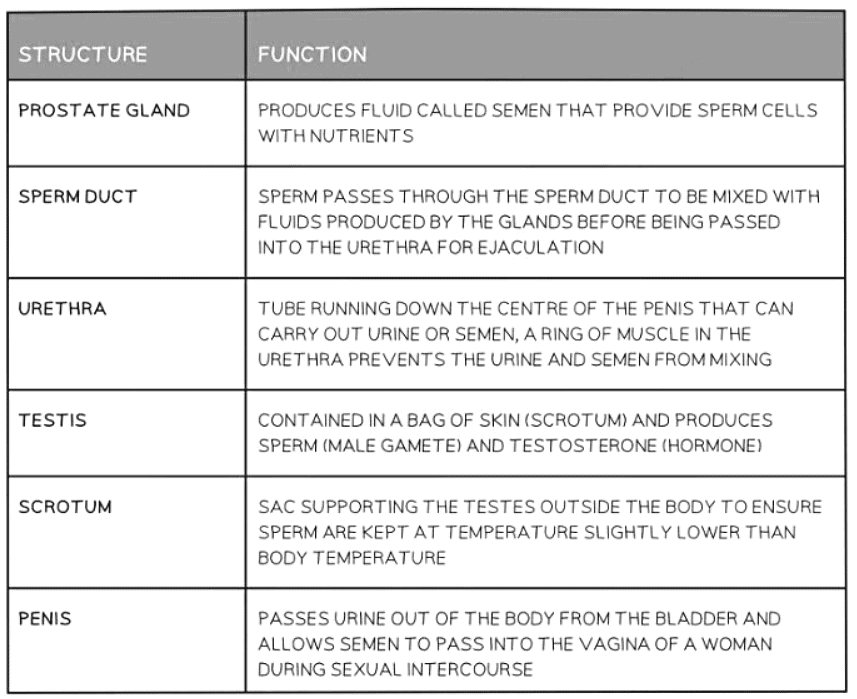Year 11 Exam > Year 11 Notes > Biology for GCSE/IGCSE > Sexual Reproduction in Humans
Sexual Reproduction in Humans | Biology for GCSE/IGCSE - Year 11 PDF Download
| Table of contents |

|
| The Male Reproduction System |

|
| The Female Reproduction System |

|
| Gametes & Fertilisation |

|
| Adaptations in Gametes |

|
| Pregnancy: Growth & Development of the Fetus |

|
| The Placenta & Umbilical Cord |

|
The Male Reproduction System

Male reproductive structures and their function

The Female Reproduction System

Female reproductive structures and their function

Gametes & Fertilisation
- Fertilisation involves the merging of the nuclei from a male gamete (sperm cell) and a female gamete (egg cell). This crucial process occurs within the oviducts.
- Male and female gametes possess specific adaptations that enhance the likelihood of successful fertilisation and subsequent embryo development.


Adaptations in Gametes

Comparison of Male & Female Gametes

Pregnancy: Growth & Development of the Fetus
- Following fertilization in the oviduct, the zygote embarks on a journey towards the uterus, a process taking approximately 3 days.
- During this period, the zygote undergoes multiple divisions, forming an embryo—a cluster of cells with the potential for further development.
- Upon reaching the uterus, the embryo implants itself into the uterine lining, initiating a series of growth and developmental stages.
- Human gestation lasts for about 9 months, with crucial organ formation occurring within the initial 12 weeks.
- During this early period, the embryo receives essential nutrients from the mother via diffusion through the uterine lining.
- Once organogenesis is complete and the placenta is established, the embryo transitions into a fetus.
- Throughout the remaining gestation period, the fetus primarily focuses on increasing in size and maturing.

- The fetus resides in the uterus and is enveloped by the amniotic sac, which contains amniotic fluid derived from the mother's blood plasma. This fluid serves as a protective cushion, safeguarding the fetus from impacts on the mother's abdomen.
- The umbilical cord plays a crucial role in connecting the fetus's circulatory system to the placenta. It facilitates the exchange of nutrients and the elimination of waste products, ensuring the fetus's growth and development.
Question for Sexual Reproduction in HumansTry yourself: What is the role of the oviduct in the process of fertilisation?View Solution
The Placenta & Umbilical Cord
- During gestation, the fetus grows and develops by obtaining glucose, amino acids, fats, water, and oxygen from the mother’s blood.
- In the placenta, the maternal and fetal blood run in opposite directions and do not mix.
- The fetus’s blood connects to and from the placenta via the umbilical cord.
- The mother’s blood removes waste products like carbon dioxide and urea from the fetus’s blood in the placenta to prevent toxic accumulation.
- Molecule movement across the placenta occurs by diffusion due to concentration gradient differences.
- The placenta is optimized for diffusion with a large surface area and thin walls.
- It also serves as a barrier to prevent toxins and pathogens from entering the fetus’s blood.
- However, not all toxins or pathogens are blocked; for example, certain viruses like rubella can pass through.
- Pregnant women are advised against smoking because harmful molecules like nicotine can cross the placenta.
- After birth, the umbilical cord is cut; this is painless as it contains no nerves, only two blood vessels.
- The umbilical cord is tied off to stop bleeding, shrivels, and falls off after a few days, leaving the belly button.
- The placenta detaches from the uterus wall shortly after birth and is expelled as the afterbirth due to uterine contractions.

The document Sexual Reproduction in Humans | Biology for GCSE/IGCSE - Year 11 is a part of the Year 11 Course Biology for GCSE/IGCSE.
All you need of Year 11 at this link: Year 11
|
110 videos|158 docs|34 tests
|
FAQs on Sexual Reproduction in Humans - Biology for GCSE/IGCSE - Year 11
| 1. What are the primary organs of the male reproductive system? |  |
Ans. The primary organs of the male reproductive system are the testes, which produce sperm and the hormone testosterone.
| 2. How does fertilization occur in humans? |  |
Ans. Fertilization in humans occurs when a sperm cell from the male meets an egg cell from the female in the fallopian tube, forming a zygote.
| 3. What is the function of the placenta during pregnancy? |  |
Ans. The placenta is responsible for providing oxygen and nutrients from the mother's blood to the fetus, as well as removing waste products from the fetus's blood.
| 4. What are gametes and what is their role in sexual reproduction? |  |
Ans. Gametes are sex cells, specifically sperm in males and egg cells in females. They are essential for sexual reproduction as they combine during fertilization to form a zygote.
| 5. How does the growth and development of the fetus occur during pregnancy? |  |
Ans. The fetus grows and develops during pregnancy through cell division, organ formation, and the exchange of nutrients and waste products between the mother and fetus through the placenta and umbilical cord.

|
Explore Courses for Year 11 exam
|

|
Signup for Free!
Signup to see your scores go up within 7 days! Learn & Practice with 1000+ FREE Notes, Videos & Tests.
Related Searches
















